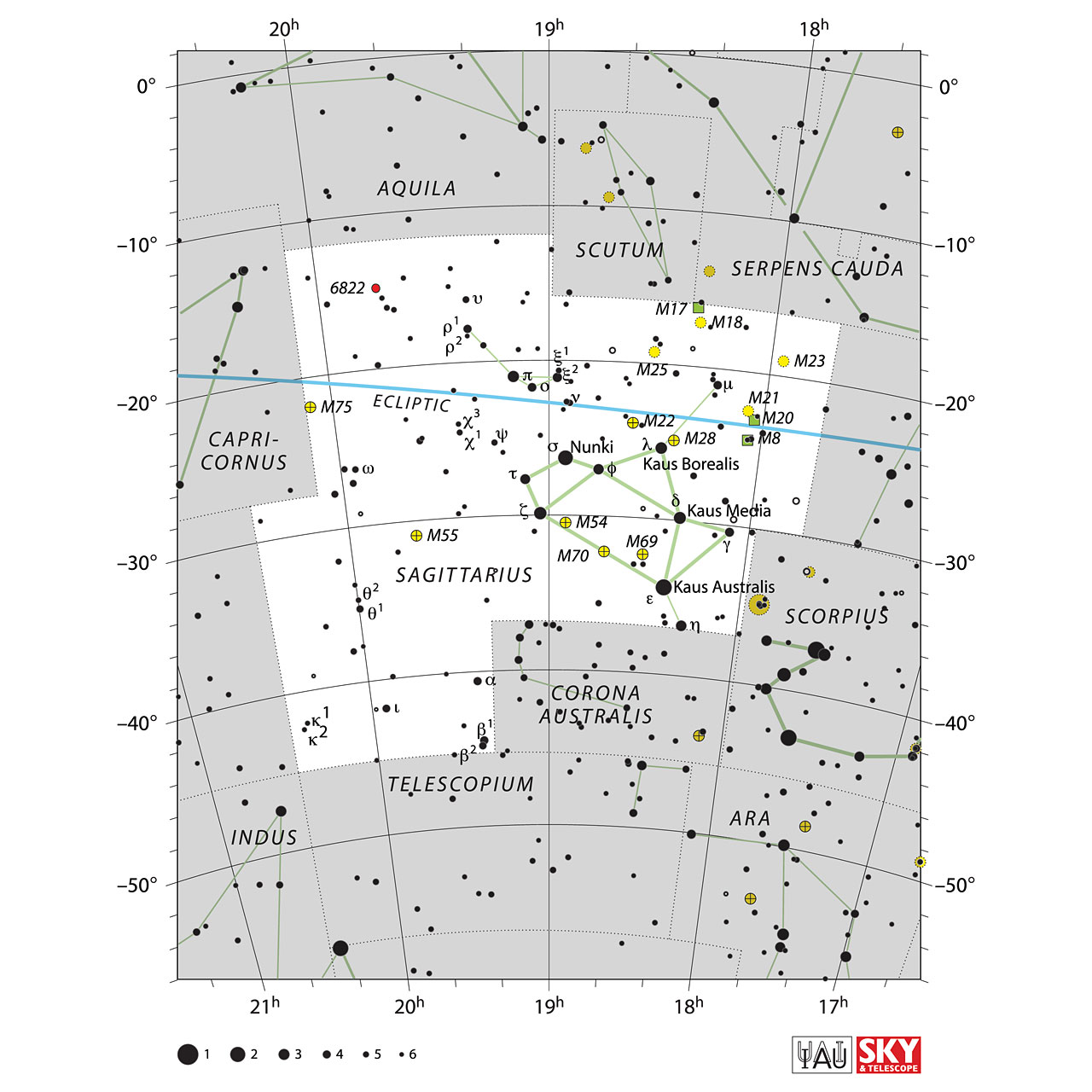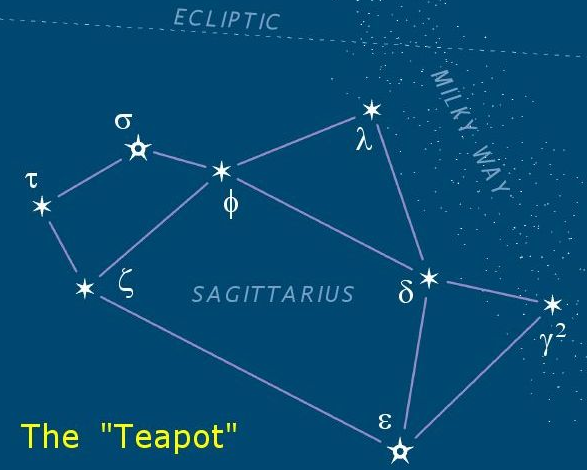
| Version | Summary | Created by | Modification | Content Size | Created at | Operation |
|---|---|---|---|---|---|---|
| 1 | Encyclopedia Editorial Office | -- | 1371 | 2024-03-15 03:37:43 |
Video Upload Options
Sagittarius, often referred to as "the Archer," is a prominent constellation in the southern celestial hemisphere, renowned for its association with Greek mythology and the mythical centaur Chiron. Positioned along the Milky Way, Sagittarius hosts a wealth of celestial wonders, including the galactic center and numerous star clusters.
1. Introduction
Sagittarius, Latin for "the Archer," is a prominent constellation in the southern celestial hemisphere, known for its rich mythology and prominent position along the Milky Way. Represented as a centaur drawing a bow, Sagittarius is one of the 88 recognized constellations and holds significance in both ancient and modern astronomy. Characterized by its distinctive teapot shape, Sagittarius is easily recognizable in the night sky, particularly during the summer months in the Northern Hemisphere and throughout the year in the Southern Hemisphere. Its celestial coordinates lie between approximately 240 and 270 degrees of right ascension and -25 to -55 degrees of declination, placing it in close proximity to the constellations Scorpius, Capricornus, and Ophiuchus (Figure 1).
At the heart of Sagittarius lies the galactic center of the Milky Way, a region of intense star formation and activity. This area hosts numerous star clusters, nebulae, and other deep-sky objects, making it a popular target for astronomers seeking to explore the mysteries of our galaxy. The constellation's association with the galactic center adds to its allure and cultural significance, inspiring wonder and curiosity about the cosmos. Sagittarius is also home to several bright stars, including Epsilon Sagittarii, and the prominent asterism known as the "Teapot," formed by the arrangement of stars representing the spout, lid, and handle of a celestial teapot. These stars contribute to the constellation's distinctive appearance and serve as navigational markers for astronomers and skywatchers.

Figure 1. IAU chart of Sagittarius. Source: https://www.iau.org/static/archives/images/screen/sgr.jpg. Credit: IAU and Sky & Telescope. Reproduced under CC BY 4.0 license.
2. Historical Background and Mythology
Sagittarius, the archer, has a rich history and cultural significance that spans across ancient civilizations and diverse cultures. In ancient Mesopotamia, the constellation Sagittarius was associated with various mythological figures and celestial omens. Babylonian astronomers recorded its movements in cuneiform tablets, linking its appearance in the sky with seasonal changes and agricultural cycles. The centaur-like figure of Sagittarius was often depicted in Babylonian art and astrology as a symbol of power and wisdom.
In Greek mythology, Sagittarius is often associated with the centaur Chiron, a wise and noble creature known for his skill in archery and medicine. Chiron was revered as a teacher and mentor to heroes such as Hercules and Achilles, imparting his knowledge and wisdom to future generations. According to legend, Chiron was accidentally wounded by a poisoned arrow and, unable to bear the pain, he relinquished his immortality and ascended to the heavens as the constellation Sagittarius. Another mythological interpretation of Sagittarius in Greek mythology relates to the centaur Pholus. Pholus was known for his association with wine and revelry and is depicted in the constellation as holding a goblet or cup. According to myth, Hercules visited Pholus during his quest for the Golden Apples of the Hesperides, and a tragic accident ensued, leading to Pholus's demise. As a tribute to his sacrifice, Pholus was immortalized in the stars as the constellation Sagittarius.
Across various indigenous cultures, Sagittarius held diverse meanings and significance. In Aboriginal Australian mythology, Sagittarius was often associated with the Emu in the Sky, a celestial figure formed by the dark rifts of the Milky Way resembling the outline of an emu. The appearance of Sagittarius in the night sky signaled the changing seasons and the time for hunting and gathering. In Polynesian and Maori cultures, Sagittarius was often depicted as a figure holding a weapon or a spear, symbolizing strength, protection, and guidance. The constellation's appearance in the sky served as a navigational aid for seafaring voyagers, guiding them on their journeys across the vast Pacific Ocean.
3. Notable Stars
3.1. Epsilon Sagittarii (Kaus Australis)
Epsilon Sagittarii, also known as Kaus Australis, is one of the brightest stars in the constellation Sagittarius. Its name, Kaus Australis, is derived from the Arabic phrase meaning "the southern part of the bow." As the brightest star in Sagittarius, Kaus Australis serves as the tip of the celestial Archer's arrow. It is a blue-white giant star located approximately 143 light-years away from Earth, with a visual magnitude of approximately 1.79. Kaus Australis is part of a multiple star system, with several companion stars orbiting the primary star.
3.2. Sigma Sagittarii (Nunki)
Sigma Sagittarii, also known as Nunki, is another prominent star in the constellation Sagittarius. Its name, Nunki, is derived from the Babylonian term meaning "the Prince of the Earth." Nunki is a blue-white main-sequence star located approximately 228 light-years away from Earth, with a visual magnitude of approximately 2.05.
An easily recognizable asterism known as "the Teapot" can be seen in Sagittarius (Figure 2). The body of the teapot is delineated by four principal stars: δ Sgr (Kaus Media), ε Sgr (Kaus Australis), ζ Sgr (Ascella), and φ Sgr, which collectively form the rounded form of the pot. Positioned as the point of the teapot's lid is λ Sgr (Kaus Borealis), adding to its distinctive appearance. Meanwhile, γ2 Sgr (Alnasl) serves as the tip of the teapot's spout. Additionally, marking the bottom of the teapot's "handle," or the shoulder area of the archer, are two notable stars: Zeta Sagittarii (ζ Sgr), known as Ascella, with a magnitude of 2.59, and Tau Sagittarii (τ Sgr).

Figure 2. The "Teapot" asterism is in Sagittarius. https://commons.wikimedia.org/wiki/File:Sagittarius-teapot-asterism.jpg. Credit: Eoghanacht, Public domain, via Wikimedia Commons.
4. Deep-Sky Objects
4.1. Messier 8 (M8) - The Lagoon Nebula
The Lagoon Nebula, designated Messier 8 (M8), is a large and bright emission nebula located in the constellation Sagittarius. It is situated approximately 4,100 light-years away from Earth and spans over 100 light-years in diameter. The Lagoon Nebula is characterized by its vibrant colors, with regions of glowing hydrogen gas illuminated by young, hot stars. Within the nebula, dense clouds of dust and gas serve as stellar nurseries, giving birth to new generations of stars. The Lagoon Nebula is a popular target for amateur astronomers and astrophotographers due to its striking appearance and proximity to Earth.
4.2. Messier 20 (M20) - The Trifid Nebula
The Trifid Nebula, designated Messier 20 (M20), is another prominent emission nebula located in Sagittarius, situated approximately 5,200 light-years away from Earth. Its name, "Trifid," refers to its distinctive appearance, characterized by dark lanes of dust that divide the nebula into three distinct sections. The Trifid Nebula is a site of active star formation, with young, massive stars illuminating the surrounding gas clouds and creating intricate structures of glowing hydrogen gas. It is also home to several star clusters and protostars.
4.3. Messier 17 (M17) - The Omega Nebula
The Omega Nebula, designated Messier 17 (M17) or the Swan Nebula, is a large and bright emission nebula located in Sagittarius, approximately 5,500 light-years away from Earth. Its name, "Omega," refers to its resemblance to the Greek letter Ω when viewed through a telescope. The Omega Nebula is one of the youngest and most active star-forming regions in the Milky Way galaxy, with massive, hot stars illuminating the surrounding gas clouds and creating intricate structures of glowing hydrogen gas and dust.
4.4. Messier 22 (M22) - The Sagittarius Globular Cluster
The Sagittarius Globular Cluster, designated Messier 22 (M22), is one of the brightest and largest globular clusters in the Milky Way galaxy, located in the constellation Sagittarius. It is situated approximately 10,600 light-years away from Earth and contains hundreds of thousands of stars densely packed within a spherical region of space. M22 is estimated to be around 12 billion years old, making it one of the oldest known globular clusters in the galaxy. Its dense core and halo of stars make it a captivating sight through telescopes.
4.5. Messier 28 (M28) - The Sagittarius Globular Cluster
Messier 28 (M28) is another globular cluster located in Sagittarius, approximately 18,000 light-years away from Earth. It is one of the densest and most compact globular clusters in the Milky Way galaxy, with a high concentration of stars at its core. M28 is estimated to be around 12 billion years old and contains hundreds of thousands of stars, making it a valuable target for astronomers studying the structure and dynamics of globular clusters. Its proximity to the galactic center adds to its scientific significance.




